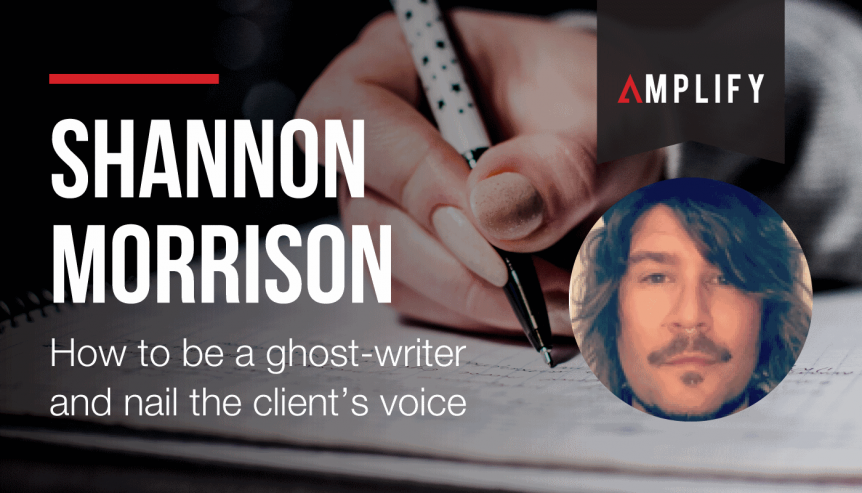Being a ghost-writer sounds like a cool job, doesn’t it? The writer haunts the words that you read, like something from a horror movie. The reality is only slightly less cool than a haunted book. A ghost-writer creates copy – which could be an article or a book – and their own unique voice disappears, like a ghost, into the background of the text, and the person they are writing for comes to the foreground. Ghost-writing is a few steps further than say, having to write a formal letter to your boss vs. sending a text message to a good friend.
When you write, you naturally fall into patterns of language that you are familiar with. This is where writing as someone else requires you to take on board the speech patterns and personality of the person you are writing for to convince the reader that this was written by THAT person.
But how exactly do I find the voice of someone else? Working with my Amplify clients, I take the time to find the right tone and language to write as them, which requires me to get to know that person. I need to spend time with them, either in person of via recordings like podcasts or skype calls, so I can pick up their personality. From there, I create a detailed portfolio for each client that allows me to translate their personality into words.
A quick description
I describe the client in three adjectives. For example: friendly, passionate and funny. This gives me a good, succinct idea of who the client is in their interactions. The initial content interviews are great for this as those first few show me how the client wants to be perceived. Once I get in a regular pattern with a client, I usually get to see a bit more of their relaxed versions of themselves, which isn’t how they will typically like their readers to see them.
Who is the reader?
I get into the mindset of my client’s ideal reader. Who are they? What are they like? Why are they reading my client’s articles? I then spend some time working on a profile of the reader, an example would be: ‘The reader is smart. He has a sense of humour, and likes actionable details in the articles he reads. He is savvy when it comes to technology and finance. He’s sarcastic and fun, but doesn’t like to waste time. And he loves red wine.’
What do they like to read?
I ask my clients to give me five books, articles or blogs that they like to read. I then spend time examining them. This can tell me a lot about a client’s written voice as most people gravitate towards content that reflects themselves. An example would be a client who likes to read the Wall Street Journal, they will more-than-likely want their articles to be fact heavy and written in a matter-of-fact way, with light-hearted phrases throughout.
Are they a Kardashian or Klimt?
Asking my clients who their favourite artistic and cultural influences are is another great way to find their voice. Getting into your client’s mindset is key to ghost-writing, so knowing if they follow pop culture trends or prefer art galleries can help to create their voice. This is also a great way of connecting their content to their readers by creating links from their own content pieces to cultural influences which can help to create a deeper connection between the client and their reader.

Write with freedom
Free-writing is a solid way of capturing a client’s voice. When I am first getting to know a client, I open a blank page and just go nuts. Right after the initial content interviews, I will write down paragraphs of notes based on the interview and try to capture the client’s voice. This works especially well when I am working with a client that I am similar too. I usually have to add in a few extra layers of discovery to really nail the writing style of the client if I don’t share a lot of hobbies or values with them.
Read, read and read some more
If possible, I get my hands on as much copy that they have written themselves. This could be a LinkedIn profile, a previous article, emails, etc. Anything that has been written by the client can give me a great advantage to capturing their preferred writing style – it allows me to adopt their writing voice relatively simply.
Listen for clues
During the content interviews, I make a point of writing down specific phrases that the client uses to address questions. This is always useful when the client is providing a technical answer to a process or an industry standard practice. Understanding how my client uses the phrases and wording that is common across their industry in their own normal speaking patterns allows me to adopt their writing style effectively. It also helps with editing their articles, as I can go back to the interview and re-listen to it. If the wording doesn’t fit, then I know I haven’t hit the right voice for that article.
Imitation is the key
Once I have written my article, I make the point of reading the article in my client’s voice. This might sound a little odd, but one of the best tools a writer has in editing their pieces is reading their copy out loud. This highlights quickly where sentences have fallen flat or pacing is out of whack. When writing pieces for clients, mimicking their voice and the way they speak helps me to hear if the article sounds like something they would write, or if it’s way off the mark.
There is a lot of work that goes into making sure that the words that are written sound like they come from the client you are writing for. The true mastery of a ghost-writer is to disappear into the copy, and to deliver a piece that people who know your client would have no idea wasn’t written by them. I guess it really is a super power after all.
Author: Ronsley Vaz
Ronsley is the founder & chief day dreamer at AMPLIFY. He is an author, speaker & serial entrepreneur.
He has a Masters’ degree in Software Engineering and an MBA in Psychology and Leadership. He is known as the creator of We Are Podcast – the first Podcasting Conference in the Southern Hemisphere, and the host of The Bond Appetit Podcast and Should I Start a Podcast. He has an audience of over 3 million in 133 countries.



Comments 1
Good day
I was impressed by your explanation about the process of ghost-writing a book;
Thanks a lot